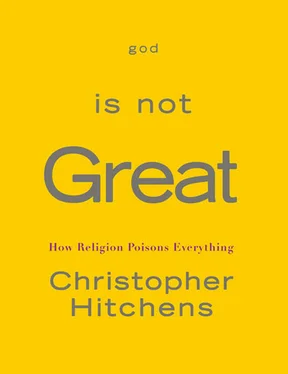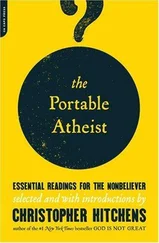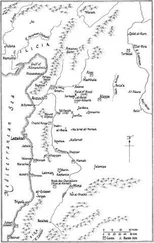The simple fact is that the New Testament, as we know it, is a helter-skelter accumulation of more or less discordant documents, some of them probably of respectable origin but others palpably apocryphal, and that most of them, the good along with the bad, show unmistakable signs of having been tampered with.
Both Paine and Mencken, who put themselves for different reasons to an honest effort to read the texts, have been borne out by later biblical scholarship, much of it first embarked upon to show that the texts were still relevant. But this argument takes place over the heads of those to whom the “Good Book” is all that is required. (One recalls the governor of Texas who, asked if the Bible should also be taught in Spanish, replied that “if English was good enough for Jesus, then it’s good enough for me.” Rightly are the simple so called.)
In 2004, a soap-opera film about the death of Jesus was produced by an Australian fascist and ham actor named Mel Gibson. Mr. Gibson adheres to a crackpot and schismatic Catholic sect consisting mainly of himself and of his even more thuggish father, and has stated that it is a pity that his own dear wife is going to hell because she does not accept the correct sacraments. (This foul doom he calmly describes as “a statement from the chair.”) The doctrine of his own sect is explicitly anti-Semitic, and the movie sought tirelessly to lay the blame for the Crucifixion upon the Jews. In spite of this obvious bigotry, which did lead to criticism from some more cautious Christians, The Passion of the Christ was opportunistically employed by many “mainstream” churches as a box-office recruiting tool. At one of the ecumenical prepublicity events which he sponsored, Mr. Gibson defended his filmic farrago—which is also an exercise in sadomasochistic homoeroticism starring a talentless lead actor who was apparently born in Iceland or Minnesota—as being based on the reports of “eyewitnesses.” At the time, I thought it extraordinary that a multimillion-dollar hit could be openly based on such a patently fraudulent claim, but nobody seemed to turn a hair. Even Jewish authorities were largely silent. But then, some of them wanted to dampen down this old argument, which for centuries had led to Easter pogroms against the “Christ-killing Jews.” (It was not until two decades after the Second World War that the Vatican formally withdrew the charge of “deicide” against the Jewish people as a whole.) And the truth is that the Jews used to claim credit for the Crucifixion. Maimonides described the punishment of the detestable Nazarene heretic as one of the greatest achievements of the Jewish elders, insisted that the name Jesus never be mentioned except when accompanied by a curse, and announced that his punishment was to be boiled in excrement for all eternity. What a good Catholic Maimonides would have made!
However, he fell into the same error as do the Christians, in assuming that the four Gospels were in any sense a historical record. Their multiple authors—none of whom published anything until many decades after the Crucifixion—cannot agree on anything of importance. Matthew and Luke cannot concur on the Virgin Birth or the genealogy of Jesus. They flatly contradict each other on the “Flight into Egypt,” Matthew saying that Joseph was “warned in a dream” to make an immediate escape and Luke saying that all three stayed in Bethlehem until Mary’s “purification according to the laws of Moses,” which would make it forty days, and then went back to Nazareth via Jerusalem. (Incidentally, if the dash to Egypt to conceal a child from Herod’s infanticide campaign has any truth to it, then Hollywood and many, many Christian iconographers have been deceiving us. It would have been very difficult to take a blond, blue-eyed baby to the Nile delta without attracting rather than avoiding attention.)
The Gospel according to Luke states that the miraculous birth occurred in a year when the Emperor Caesar Augustus ordered a census for the purpose of taxation, and that this happened at a time when Herod reigned in Judaea and Quirinius was governor of Syria. That is the closest to a triangulation of historical dating that any biblical writer even attempts. But Herod died four years “BC,” and during his rulership the governor of Syria was not Quirinius. There is no mention of any Augustan census by any Roman historian, but the Jewish chronicler Josephus mentions one that did occur—without the onerous requirement for people to return to their places of birth, and six years after the birth of Jesus is supposed to have taken place. This is, all of it, quite evidently a garbled and oral-based reconstruction undertaken some considerable time after the “fact.” The scribes cannot even agree on the mythical elements: they disagree wildly about the Sermon on the Mount, the anointing of Jesus, the treachery of Judas, and Peter’s haunting “denial.” Most astonishingly, they cannot converge on a common account of the Crucifixion or the Resurrection. Thus, the one interpretation that we simply have to discard is the one that claims divine warrant for all four of them. The book on which all four may possibly have been based, known speculatively to scholars as “Q,” has been lost forever, which seems distinctly careless on the part of the god who is claimed to have “inspired” it.
Sixty years ago, at Nag Hammadi in Egypt, a trove of neglected “Gospels” was discovered near a very ancient Coptic Christian site. These scrolls were of the same period and provenance as many of the subsequently canonical and “authorized” Gospels, and have long gone under the collective name of “Gnostic.” This was the title given them by a certain Irenaeus, an early church father who placed them under a ban as heretical. They include the “Gospels” or narratives of marginal but significant figures in the accepted “New” Testament, such as “Doubting Thomas” and Mary Magdalene. They now also include the Gospel of Judas, known for centuries to have existed but now brought to light and published by the National Geographic Society in the spring of 2006.
The book is chiefly spiritualist drivel, as one might expect, but it offers a version of “events” that is fractionally more credible than the official account. For one thing, it maintains as do its partner texts that the supposed god of the “Old” Testament is the one to be avoided, a ghastly emanation from sick minds. (This makes it easy to see why it was so firmly banned and denounced: orthodox Christianity is nothing if it is not a vindication and completion of that evil story.) Judas attends the final Passover meal, as usual, but departs from the customary script. When Jesus appears to pity his other disciples for knowing so little about what is at stake, his rogue follower boldly says that he believes he knows what the difficulty is. “I know who you are and where you have come from,” he tells the leader. “You are from the immortal realm of Barbelo.” This “Barbelo” is not a god but a heavenly destination, a motherland beyond the stars. Jesus comes from this celestial realm, but is not the son of any Mosaic god. Instead, he is an avatar of Seth, the third and little-known son of Adam. He is the one who will show the Sethians the way home. Recognizing that Judas is at least a minor adept of this cult, Jesus takes him to one side and awards him the special mission of helping him shed his fleshly form and thus return heavenward. He also promises to show him the stars that will enable Judas to follow on.
Deranged science fiction though this is, it makes infinitely more sense than the everlasting curse placed on Judas for doing what somebody had to do, in this otherwise pedantically arranged chronicle of a death foretold. It also makes infinitely more sense than blaming the Jews for all eternity. For a long time, there was incandescent debate over which of the “Gospels” should be regarded as divinely inspired. Some argued for these and some for others, and many a life was horribly lost on the proposition. Nobody dared say that they were all man-inscribed long after the supposed drama was over, and the “Revelation” of Saint John seems to have squeezed into the canon because of its author’s (rather ordinary) name. But as Jorge Luis Borges put it, had the Alexandrian Gnostics won the day, some later Dante would have drawn us a hypnotically beautiful word-picture of the wonders of “Barbelo.” This concept I might choose to call “the Borges shale”: the verve and imagination needed to visualize a cross section of evolutionary branches and bushes, with the extraordinary but real possibility that a different stem or line (or tune or poem) had predominated in the labyrinth. Great ceilings and steeples and hymns, he might have added, would have consecrated it, and skilled torturers would have worked for days on those who doubted the truth of Barbelo: beginning with the fingernails and working their way ingeniously toward the testicles, the vagina, the eyes, and the viscera. Nonbelief in Barbelo would, correspondingly, have been an unfailing sign that one had no morals at all.
Читать дальше












